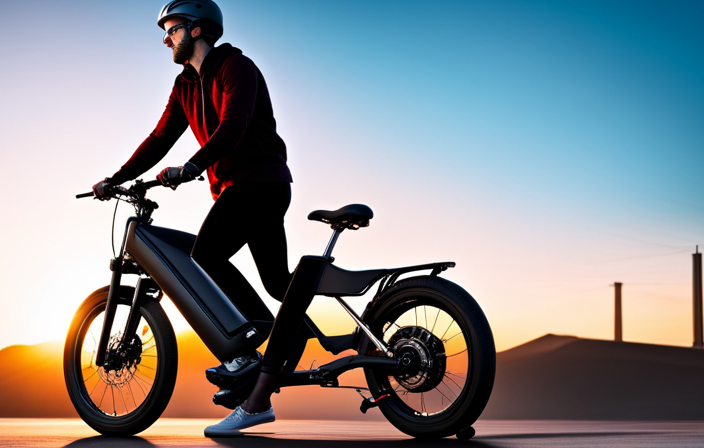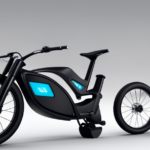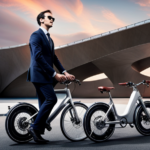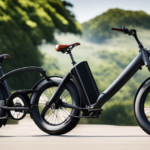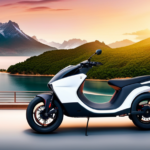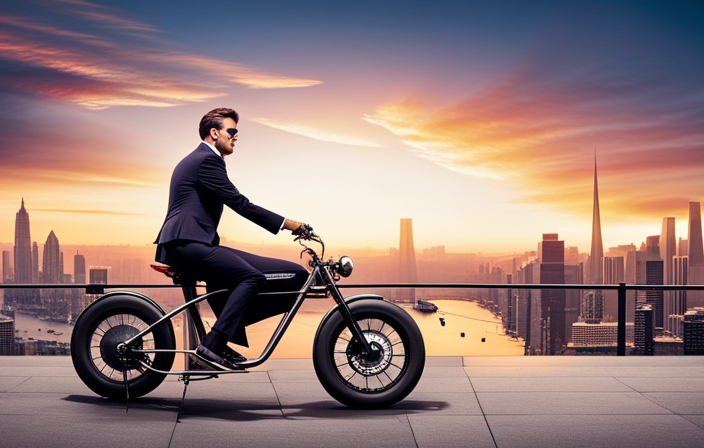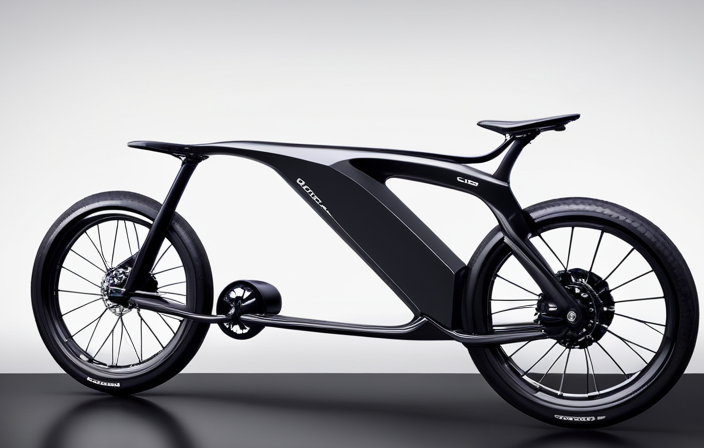As I delve into the world of electric bikes, I find myself pondering the question: how long does an electric bike run?
This query, like a winding road, leads us on a journey of exploration and analysis.
In this article, we will dissect the factors that determine the range of an electric bike, including battery capacity, motor power, terrain, rider weight, and riding style.
By understanding these variables, we can make informed decisions and choose the right electric bike that meets our range needs.
Key Takeaways
- The range of an electric bike is affected by various factors such as battery capacity, motor power efficiency, rider weight, terrain, tire pressure, riding style, and battery age.
- Tips for extending the electric bike range include maintaining a steady speed, avoiding sudden acceleration or braking, pedaling along with electric assistance, using lower power mode or reducing assistance level, and keeping tires properly inflated.
- Battery replacement or upgrades may be necessary if the battery shows signs of deterioration or if upgrading to higher capacity batteries is desired. Cost considerations should be taken into account for battery replacement or upgrades.
- When comparing electric bike range, it is important to compare the range across different electric bike models, consider the range comparison of popular electric bike brands, and understand the factors that differentiate range among models. Additionally, researching and understanding range specifications, battery capacity, and real-life experiences from riders can provide valuable insights.
Understanding Electric Bike Batteries
Electric bike batteries play a crucial role in determining how long an electric bike can run. Understanding electric bike battery technology is essential to maximize the performance and range of an electric bike.
One key aspect of battery technology is understanding battery capacity. Battery capacity refers to the amount of energy the battery can store, usually measured in watt-hours (Wh). The higher the battery capacity, the longer the electric bike can run before needing to be recharged. Factors that affect battery capacity include the type of battery chemistry used, the number of cells in the battery pack, and the overall quality of the battery.
By choosing a battery with higher capacity, riders can enjoy longer rides without worrying about running out of power.
Transitioning into the role of motor power, the right combination of battery capacity and motor power can significantly enhance the overall performance and range of an electric bike.
The Role of Motor Power
To maximize the distance you can travel on an e-bike, consider the role of motor power. The efficiency of the motor power greatly affects the overall performance of the e-bike, especially when it comes to tackling uphill terrains. Here are three key factors to consider:
-
Motor power efficiency: A more efficient motor will convert a higher percentage of the battery’s energy into power, allowing you to travel longer distances. Look for e-bikes with motors that have high efficiency ratings.
-
Impact of motor power on uphill performance: The higher the motor power, the easier it will be for the e-bike to climb uphill. A more powerful motor can provide the necessary torque to overcome steep inclines without exerting excessive effort.
-
Battery life and motor power: It’s important to find a balance between motor power and battery life. A higher motor power may drain the battery faster, reducing the overall range of the e-bike.
Considering these factors will help you make an informed decision when choosing an e-bike with the right motor power for your needs. Understanding how motor power impacts uphill performance is crucial for maximizing the range of your e-bike.
Now, let’s explore the impact of terrain on range.
Terrain and Its Impact on Range
Understanding how different types of terrain affect the range of an e-bike is crucial for choosing the right motor power. When it comes to range and elevation, it’s important to consider how steep the terrain is and how much elevation gain there will be during your ride. Uphill climbs will significantly reduce the range of your e-bike, as the motor will have to work harder to overcome the resistance. On the other hand, downhill descents can actually extend the range of your e-bike, as the motor can regenerate power while braking. Additionally, tire pressure plays a role in the range of an e-bike. Higher tire pressure can reduce rolling resistance, allowing for longer distances on flat terrain. However, on rougher terrain, lower tire pressure can provide better traction and comfort, albeit at the cost of reduced range.
| Terrain Type | Impact on Range |
|---|---|
| Uphill | Decreases |
| Downhill | Increases |
| Flat | Neutral |
| Rough | Decreases |
Considering the impact of terrain and tire pressure is essential for optimizing the range of your e-bike. However, it’s not the only factor to consider. Another important aspect to take into account is rider weight and its effect on battery life.
Rider Weight and Its Effect on Battery Life
Considering your weight is essential for optimizing the battery life of your e-bike. The impact of rider weight on battery life can be significant, as it affects the energy consumption and overall range of the bike. Here are four key factors to consider:
-
Energy Consumption: Heavier riders require more power to move the bike, resulting in increased energy consumption and reduced battery life.
-
Incline Effect: When riding uphill, the motor has to work harder to overcome gravity. This increased power demand can drain the battery faster, especially for heavier riders.
-
Tire Pressure: Proper tire pressure is crucial for efficient riding. Insufficient pressure increases rolling resistance, making the motor work harder and reducing battery life.
-
Range Reduction: The combined effect of rider weight, incline, and tire pressure can lead to a significant reduction in the overall range of the e-bike.
Understanding these factors will help you make informed decisions about your e-bike usage and optimize battery life.
Now, let’s delve into the next section about riding style and its influence on battery life.
Riding Style and Its Influence on Battery Life
When it comes to conserving energy on an electric bike, efficient riding is key. This means focusing on techniques that minimize energy consumption. Techniques such as maintaining a steady speed and avoiding sudden accelerations. The impact of speed and acceleration on range cannot be overstated. Higher speeds and quick accelerations can significantly decrease battery life.
Utilizing pedal assist and power modes can help optimize energy usage. These modes provide additional support when needed, while still allowing for a more efficient and enjoyable riding experience.
Conserving Energy through Efficient Riding
To conserve energy while riding your electric bike, you can pedal lightly and avoid sudden accelerations or decelerations. These energy-saving techniques are essential for maximizing your electric bike’s efficiency.
Pedaling lightly allows the motor to do less work, reducing the amount of energy consumed. By maintaining a steady pace and avoiding abrupt changes in speed, you can also minimize the strain on the battery. Additionally, using your bike’s gears effectively can further optimize energy usage.
Shifting to a lower gear when climbing hills or facing headwinds will make it easier for you to pedal and reduce the load on the motor. By adopting these energy-saving techniques, you can extend the range of your electric bike and enjoy longer rides.
Now let’s explore the impact of speed and acceleration on range.
Impact of Speed and Acceleration on Range
You should be aware that your speed and acceleration directly affect the range of your electric bike. Maintaining an optimal speed and smooth acceleration can significantly increase your bike’s range.
Here are some key factors to consider:
-
Weight Distribution: Properly distributing the weight on your electric bike can have a significant impact on its range. Ensure that the weight is evenly balanced between the front and rear wheels to maximize efficiency.
-
Tire Pressure: Maintaining the correct tire pressure is crucial for prolonging battery life. Underinflated tires can increase rolling resistance, requiring more power from the battery to maintain speed.
-
Aerodynamics: Minimizing wind resistance by adopting an aerodynamic riding position can improve your bike’s efficiency and extend its range.
By understanding and implementing these factors, you can optimize your electric bike’s range.
Now, let’s explore how utilizing pedal assist and power modes can further enhance your riding experience.
Utilizing Pedal Assist and Power Modes
While speed and acceleration are important factors in determining the range of an electric bike, another factor that greatly influences performance is the utilization of pedal assist and power modes.
Pedal assist mode allows the rider to pedal while receiving assistance from the electric motor, reducing the strain on the battery and extending the range.
On the other hand, power mode relies solely on the electric motor, providing maximum assistance but depleting the battery at a faster rate.
By strategically switching between these modes based on the terrain and desired level of effort, riders can optimize their bike’s performance and maximize the battery capacity.
Understanding how to effectively utilize these modes is crucial in ensuring a longer and more efficient ride.
Transitioning to the subsequent section, it is important to consider external factors that affect range.
External Factors That Affect Range
When it comes to electric bikes, there are several external factors that can affect the range and performance.
First, weather conditions and temperature play a significant role in determining how far an electric bike can go on a single charge. Cold weather tends to decrease battery performance, while hot weather can cause overheating and reduce overall efficiency.
Additionally, wind resistance can have a significant impact on battery life, as riding against a strong headwind requires more power, draining the battery faster.
Weather Conditions and Temperature
If it’s too hot or too cold outside, it can affect how long your electric bike runs. Weather conditions and temperature play a crucial role in determining the range of your e-bike.
When it comes to range estimation, extreme temperatures have a significant impact on battery life. High temperatures can cause the battery to overheat, leading to a decrease in its capacity and overall performance. On the other hand, extremely cold temperatures can reduce the efficiency of the battery, resulting in reduced range.
Additionally, humidity levels can also influence the battery life of your electric bike. High humidity can lead to increased resistance, affecting the battery’s ability to deliver power efficiently.
It is important to keep these factors in mind when planning your e-bike rides. Now, let’s move on to the next section and explore the impact of wind resistance on battery life.
Wind Resistance and Its Impact on Battery Life
To optimize your e-bike’s battery life, be mindful of how wind resistance affects its overall performance.
Wind resistance plays a significant role in the battery efficiency and range of an electric bike. When riding against a headwind, the bike has to work harder to overcome the resistance, resulting in increased power consumption and reduced battery life.
The impact of wind speed on electric bike range is substantial. Higher wind speeds create greater resistance, causing the battery to drain faster. It is crucial to consider wind conditions when planning your e-bike rides to maximize battery life.
By choosing routes with less wind exposure or using wind-blocking accessories, such as fairings or windshields, you can minimize the impact of wind resistance on your e-bike’s battery efficiency. Understanding this relationship between wind resistance and battery life is essential for optimizing your e-bike’s performance.
Taking the necessary steps to minimize wind resistance will lead to improved battery life and a longer-lasting ride.
Now, let’s explore the next section about maintenance and proper care for optimal performance.
Maintenance and Proper Care for Optimal Performance
Regular maintenance and proper care are essential for ensuring optimal performance and longevity of your e-bike. It’s important to understand the best practices for electric bike battery charging and troubleshooting common electric bike issues. By following these guidelines, you can maximize the lifespan of your e-bike and avoid unnecessary repairs.
To help you keep track of your maintenance tasks, here’s a simple table outlining the recommended frequency for various maintenance activities:
| Maintenance Task | Frequency |
|---|---|
| Battery charging | After each use |
| Tire pressure check | Weekly |
| Chain lubrication | Monthly |
| Brake inspection | Every 3 months |
| Overall bike inspection | Every 6 months |
By regularly charging your electric bike battery after each use, you can ensure that it remains at its optimal capacity. Additionally, conducting regular inspections and addressing any issues promptly can prevent major problems down the line.
Understanding the importance of maintenance and proper care sets the foundation for discussing range ratings and estimates, which will be covered in the next section.
Understanding Range Ratings and Estimates
When it comes to electric bikes, understanding the range ratings and estimates is crucial. Manufacturers often provide range ratings that indicate how far the bike can go on a single charge under ideal conditions.
However, real-world range estimates may vary due to factors such as terrain, weather conditions, rider weight, and riding style. These factors can lead to deviations from the estimated range, making it important for riders to consider these variables when planning their rides.
Manufacturer’s Range Ratings
The manufacturer’s range ratings aren’t always accurate for electric bikes. Understanding range limitations and factors affecting range accuracy is crucial for realistic expectations.
The range rating provided by the manufacturer is typically based on ideal conditions, such as riding on flat terrain at a constant speed. However, real-world riding conditions can significantly impact the actual range.
Factors like terrain, wind resistance, rider weight, and tire pressure can all affect the battery’s performance and drain it faster than expected. Additionally, the power mode selected and the usage of additional features like lights and throttle also impact the range.
Therefore, relying solely on the manufacturer’s range rating may not provide an accurate estimate of how long an electric bike can run in real-world situations.
Real-World Range Estimates
Real-world riding conditions can have a significant impact on an electric bike’s range. It is important to consider factors like terrain, rider weight, and tire pressure. When estimating battery range, it is crucial to account for these variables to avoid range anxiety or unexpected power depletion during a ride.
Terrain plays a crucial role in determining battery range. Uphill climbs and rough surfaces require more energy, which reduces the overall range. Rider weight also affects battery range. Heavier riders require more power to propel the bike, which can decrease the range.
Tire pressure is another important factor to consider. Lower tire pressures result in higher resistance, which can decrease the range. It is important to maintain proper tire pressure to optimize energy consumption.
Factors That Can Lead to Deviations from Estimated Range
To avoid unexpected power depletion during your ride, it’s important to consider factors like terrain, rider weight, and tire pressure. These factors can lead to deviations from the estimated battery range.
Range limitations are a common concern for electric bike riders. Understanding the impact of battery age is crucial in managing your expectations. As the battery ages, its capacity to hold a charge diminishes, resulting in a reduced range. This means that over time, you may not be able to achieve the same distance on a single charge as when the battery was new.
It’s important to keep this in mind when planning your rides and to consider the age of your battery when assessing its performance. With this understanding of range limitations and battery age, let’s explore some tips for extending your electric bike range.
Tips for Extending Electric Bike Range
Want to extend your electric bike range? Here are some tips!
One of the key factors in maximizing your battery life and optimizing power consumption is to ride in an efficient manner. Start by maintaining a steady speed and avoiding sudden acceleration or braking. Additionally, try to pedal along with the electric assistance to reduce reliance on the motor.
Another way to extend the range is to lower the power mode or reduce the assistance level when you don’t need the extra boost.
Finally, keeping your tires properly inflated and ensuring your bike is well-maintained can also contribute to increased efficiency.
By following these tips, you can make the most out of your electric bike’s battery life and enjoy longer rides.
Looking ahead to battery replacement and upgrades, there are other considerations to explore.
Battery Replacement and Upgrades
In this discussion, I will explore the signs that indicate your electric bike battery needs replacement. Warning signs such as decreased range, difficulty holding a charge, or an inability to provide sufficient power are important indicators to look out for.
The benefits and considerations of upgrading to higher capacity batteries are also worth exploring. Upgrading can significantly improve your electric bike’s performance and extend its range. However, it is crucial to consider factors such as compatibility, weight, and cost before making a decision.
Speaking of cost, the implications of battery replacement or upgrades should be taken into account. Understanding the signs of battery degradation and the options for replacement or upgrades will help you make informed decisions to enhance your electric bike experience.
Signs That Your Battery Needs Replacement
Hey, if you’ve noticed a significant decrease in your electric bike’s range or if it’s struggling to maintain a consistent speed, it might be a sign that your battery needs replacing.
Battery performance is crucial for the overall efficiency of your electric bike. Over time, batteries can deteriorate, resulting in reduced capacity and decreased performance.
One of the signs of battery deterioration is a noticeable decrease in range. If you used to be able to travel long distances on a single charge but now find yourself needing to recharge more frequently, it’s likely that your battery is no longer performing at its best.
Another sign is a decrease in speed consistency. If your electric bike is struggling to maintain a steady speed, it could be due to a weak battery.
Upgrading to higher capacity batteries can improve both range and speed consistency, allowing you to enjoy longer rides without any performance issues.
Upgrading to Higher Capacity Batteries
After identifying the signs that my battery needed replacement, I decided to explore the possibility of upgrading to higher capacity batteries.
This would not only address the issue of my diminishing battery life, but also increase the range of my electric bike. Increasing the battery capacity can be a smart solution for those looking to extend their riding distance without compromising performance.
By upgrading to a higher capacity battery, I can enjoy longer rides and explore new routes with confidence. Additionally, advancements in battery technology have made higher capacity options more accessible and affordable.
However, before making any decisions, it is important to consider the cost implications of battery replacement or upgrades.
Cost Considerations for Battery Replacement or Upgrades
When considering battery replacement or upgrades, it’s important to assess the financial implications.
The cost of battery replacement or upgrading can vary depending on the type of battery and its capacity.
There are several battery upgrade options available in the market, ranging from higher capacity batteries to more advanced lithium-ion batteries.
While these upgrades can enhance the performance and range of your electric bike, they may come at a higher cost.
However, it’s worth noting that there are also budget-friendly battery replacements available that can offer decent performance without breaking the bank.
By carefully evaluating your needs and budget, you can find a suitable battery replacement or upgrade that meets your requirements.
Now, let’s move on to comparing electric bike range across models and understanding the factors that affect it.
Comparing Electric Bike Range Across Models
When comparing the range of popular electric bike brands, it is important to consider several factors that can affect the distance a bike can travel on a single charge. These factors include the battery capacity, motor power, weight of the bike, terrain, and riding style.
To fully understand and compare range specifications, it is crucial to research and analyze the data provided by manufacturers, as well as reading reviews and conducting real-world tests.
Range Comparison of Popular Electric Bike Brands
To compare the range of popular electric bike brands, you’ll want to consider factors such as battery capacity and efficiency. Manufacturer comparisons can shed light on the range variability among different brands. Here is a table that showcases the range of three popular electric bike brands:
| Brand | Battery Capacity (Wh) | Range (Miles) |
|---|---|---|
| A | 500 | 50 |
| B | 750 | 60 |
| C | 1000 | 70 |
As you can see, the range of electric bikes varies depending on the battery capacity. Brand C, with a battery capacity of 1000 Wh, offers the longest range of 70 miles. On the other hand, Brand A, with a battery capacity of 500 Wh, has the shortest range of 50 miles. These manufacturer comparisons highlight the importance of battery capacity in determining the range of an electric bike. Moving forward, we will explore the factors that differentiate range among models.
Factors That Differentiate Range Among Models
If you want to understand what factors differentiate the range among different models, you’ll need to consider variables like motor power and weight. The range comparison of electric bikes depends on various factors, including advancements in battery technology.
Here are three key factors that contribute to the range variation among electric bike models:
-
Battery Capacity: The size and capacity of the battery play a crucial role in determining the range of an electric bike. A higher capacity battery can store more energy, allowing for longer rides.
-
Motor Efficiency: The efficiency of the electric motor affects the energy consumption and, consequently, the range. Motors with higher efficiency convert more electrical energy into mechanical power, maximizing the range.
-
Weight: The weight of the electric bike, including the rider and additional accessories, impacts the range. A lighter bike requires less power to move, resulting in a longer range.
Considering these factors, it becomes essential to research and understand the range specifications of different models. By doing so, you can make an informed decision when choosing an electric bike that meets your specific range requirements.
Researching and Understanding Range Specifications
After exploring the factors that differentiate range among electric bike models, it is crucial to delve into researching and understanding range specifications. This step is essential because it allows potential buyers to make informed decisions based on the estimated range of the electric bike they are interested in. The factors affecting electric bike range include battery capacity, motor power, rider weight, terrain, and riding style. By carefully analyzing these factors and comparing range estimates provided by manufacturers, riders can gain a clearer understanding of how far their electric bike will run on a single charge. To facilitate this process, I have created a table below to illustrate the estimated range of three different electric bike models based on various factors.
| Model | Battery Capacity | Motor Power | Rider Weight | Terrain | Riding Style | Estimated Range |
|---|---|---|---|---|---|---|
| A | 500Wh | 250W | 75kg | Hilly | Moderate | 50 miles |
| B | 400Wh | 350W | 85kg | Flat | Aggressive | 35 miles |
| C | 600Wh | 500W | 65kg | Mixed | Casual | 60 miles |
Understanding these range estimates is crucial as it helps riders plan their journeys, manage their battery usage, and avoid any unexpected inconveniences. With this knowledge, riders can confidently embark on their electric bike adventures, knowing how far they can go on a single charge. In the next section, we will explore testimonials and real-life experiences to gain further insight into the performance and range of electric bikes.
Testimonials and Real-Life Experiences
When it comes to electric bike range, hearing stories from actual riders can provide valuable insights. Different types of riders have different range considerations, such as the terrain they’ll be riding on, their weight, and their desired speed.
Learning from others’ experiences can help inform your choices and ensure you select an electric bike with the range that best suits your needs.
Electric Bike Range Stories from Riders
One rider reported that their electric bike ran for over 60 miles on a single charge. This demonstrates that electric bikes have come a long way in terms of range capabilities, alleviating range limitations and reducing range anxiety.
Here are three fascinating range stories from electric bike riders:
-
A commuter shared that their electric bike allowed them to travel a distance of 35 miles daily without worrying about running out of battery. This significantly extended their range and made their daily commute stress-free.
-
Another rider embarked on a challenging mountain trail and was relieved to find that their electric bike lasted for 45 miles, allowing them to explore the rugged terrain without concern.
-
A long-distance cyclist embarked on a cross-country journey and was amazed that their electric bike managed to cover an impressive 100 miles in one charge. This feat was a testament to the bike’s endurance and range capabilities.
These range stories highlight the advancements in electric bike technology, providing riders with confidence and peace of mind.
Now, let’s delve into the range considerations for different types of riders, ensuring a comprehensive understanding of electric bike capabilities.
Range Considerations for Different Types of Riders
The range capabilities of electric bikes vary depending on the type of rider and their specific needs. Range requirements can vary widely, from short commutes to long-distance rides. Battery technology advancements have played a crucial role in expanding the range capabilities of electric bikes. With improved battery technology, riders can now go farther on a single charge.
To better understand the range considerations for different types of riders, let’s take a look at the following table:
| Rider Type | Range Requirement | Battery Capacity |
|---|---|---|
| Commuter | 20-30 miles | 400-500Wh |
| Touring | 50-80 miles | 600-800Wh |
| Off-Road | 30-50 miles | 500-700Wh |
As you can see, range requirements and battery capacity vary depending on the type of rider. It’s essential to consider your specific needs and choose an electric bike with the appropriate range capabilities.
Learning from Others’ Experiences to Inform Your Choices
By listening to others’ experiences, you can gain valuable insights to inform your choices when selecting an e-bike. Customization is an important aspect to consider when looking for an electric bike that can handle long distance tours. Some riders prefer to modify their bikes with larger batteries to extend the range, while others focus on enhancing the motor power to tackle challenging terrains.
It is crucial to learn from fellow riders who have already gone on long distance electric bike tours to understand the specific modifications they made and how it affected their overall experience. By analyzing their feedback and recommendations, you can make informed decisions about the customization options that would best suit your needs. This understanding will enable you to choose an electric bike that is optimized for long distance rides and provides the necessary power and endurance.
Considering these factors will contribute to a successful and enjoyable electric bike tour.
Transition: Understanding the customizations required for long distance electric bike tours is not only beneficial for riders, but it also highlights the environmental advantages of using electric bikes.
Environmental Benefits of Electric Bikes
Reduced carbon emissions and air pollution are significant benefits of electric bikes, making them a sustainable transportation alternative. By using electric bikes instead of traditional vehicles, individuals can greatly reduce their carbon footprint and contribute to cleaner air quality.
Additionally, electric bikes can help alleviate traffic congestion by providing a more efficient and agile mode of transportation, especially in crowded urban areas.
Overall, promoting the use of electric bikes can play a crucial role in creating a more sustainable and environmentally-friendly transportation system.
Reduced Carbon Emissions and Air Pollution
Using electric bikes can help lower carbon emissions and air pollution. Electric bikes have a range of benefits and their impact on the urban environment is significant. Here are three reasons why electric bikes are an environmentally friendly transportation option:
-
Zero Emissions: Electric bikes operate on electricity, which means they produce zero tailpipe emissions. This helps to reduce the amount of harmful pollutants released into the air, improving overall air quality in urban areas.
-
Reduced Energy Consumption: Electric bikes are more energy-efficient compared to traditional vehicles. They require less energy to operate, resulting in lower carbon emissions. This is particularly important in cities where traffic congestion and air pollution are major concerns.
-
Noise Reduction: Electric bikes are quieter than vehicles powered by internal combustion engines. This results in reduced noise pollution, creating a more peaceful and enjoyable urban environment.
Impact of Electric Bikes on Traffic Congestion
Imagine how much smoother your daily commute would be without the constant gridlock caused by traffic congestion.
Electric bikes have the potential to significantly alleviate this issue by providing an alternative mode of transportation. However, for electric bikes to have a substantial impact on traffic congestion, proper infrastructure must be in place. This includes designated bike lanes, charging stations, and secure parking facilities.
By investing in electric bike infrastructure, cities can encourage more people to use this sustainable mode of transportation, reducing the number of cars on the road and easing traffic congestion.
Additionally, the impact of electric bikes on public transportation should not be overlooked. Electric bikes can serve as a first-mile or last-mile solution, complementing existing public transportation systems and further reducing the reliance on cars.
Promoting Sustainable Transportation Alternatives
To encourage sustainable transportation options, cities must invest in the necessary infrastructure for electric bikes, such as bike lanes and charging stations.
Electric bikes have the potential to revolutionize public transportation by providing a cost-effective and environmentally friendly alternative to traditional modes of transportation. One of the key factors that contribute to the affordability of electric bikes is their low operating cost. Unlike cars or motorcycles, electric bikes do not require fuel and can be recharged using electricity, which is generally cheaper than gasoline. This makes electric bikes a more accessible option for individuals who cannot afford a car or who want to reduce their transportation expenses.
Furthermore, the impact of electric bikes on public transportation is significant. By reducing the number of cars on the road, electric bikes help alleviate traffic congestion and improve air quality in cities. This, in turn, benefits public transportation systems by making them more efficient and reliable.
As more people choose electric bikes as their preferred mode of transportation, cities must also invest in electric bike charging infrastructure to support the increasing demand. This includes installing charging stations in convenient locations throughout the city, such as bike racks, parking lots, and public spaces. By doing so, cities can ensure that electric bike users have access to reliable and convenient charging options, further promoting the adoption of electric bikes as a sustainable transportation alternative.
Electric Bike Charging Infrastructure
When it comes to electric bike charging infrastructure, there are several key points to consider.
Firstly, access to charging stations and outlets is crucial for electric bike riders, as it ensures that they can conveniently recharge their bikes when needed.
Secondly, for on-the-go riders, portable charging options are a must-have, allowing them to charge their bikes even when they are away from traditional charging stations.
Access to Charging Stations and Outlets
Access to charging stations and outlets is crucial for the long-term use of electric bikes. Without a reliable charging infrastructure, electric bike riders may struggle to find convenient places to charge their bikes, limiting the distance they can travel and the overall utility of their bikes.
Here are some key factors to consider regarding access to charging infrastructure:
-
Availability of charging stations: The number of charging stations in an area directly impacts the ease of recharging an electric bike. Areas with a high density of charging stations provide more options for riders.
-
Location of charging stations: Ideally, charging stations should be strategically placed in easily accessible locations, such as near popular routes or destinations, to ensure convenience for riders.
-
Charging station compatibility: Different electric bike models may require specific charging connectors or voltage levels. Having a diverse range of charging stations that cater to various bike models is essential.
-
Charging station capacity: Charging stations should be able to handle multiple bikes simultaneously to accommodate the growing number of electric bike riders.
Considering these factors, it becomes clear that access to a well-developed charging infrastructure is essential for the widespread adoption and long-term viability of electric bikes.
Transitioning into the subsequent section about portable charging options for on-the-go riders, it is important to explore alternative solutions that can provide flexibility and convenience for riders who are constantly on the move.
Portable Charging Options for On-the-Go Riders
After exploring the limitations of relying solely on charging stations and outlets, it is essential to consider alternative options for on-the-go riders. One such option is the use of portable power banks, which provide a convenient and efficient way to recharge electric bikes without the need for a fixed power source. These power banks, equipped with high-capacity batteries, can easily be carried in a backpack or mounted on the bike itself.
Additionally, riders can take advantage of solar charging options, which harness the power of the sun to recharge their electric bikes. By utilizing portable power banks and solar charging options, riders can extend their riding range and minimize the reliance on traditional charging stations. However, it is important to also understand the proper charging etiquette and best practices to ensure optimal battery performance and longevity.
Transitioning into the subsequent section about charging etiquette and best practices…
Charging Etiquette and Best Practices
To ensure optimal battery performance, it’s important to follow proper charging etiquette and best practices. Here are some key points to keep in mind when it comes to battery charging and maintenance:
-
Charge your battery regularly: It’s recommended to charge your battery after each ride, even if it’s not fully depleted. This helps to maintain a consistent charge level and prolongs the overall lifespan of the battery.
-
Use the right charger: Always use the charger that is specifically designed for your electric bike’s battery. Using a different charger can lead to improper charging and potential damage to the battery.
-
Avoid overcharging: Once your battery is fully charged, unplug it from the charger. Overcharging can cause excess heat buildup and reduce the overall lifespan of the battery.
By following these battery charging and maintenance practices, you can ensure that your electric bike’s battery performs optimally and lasts longer.
Now, let’s dive into some tips for extending the battery lifespan and maintaining its performance.
Battery Lifespan and Maintenance Tips
When it comes to electric bike batteries, maximizing their lifespan is crucial for long-term performance and cost-effectiveness. Proper storage and care are key factors in ensuring the longevity of the battery.
Regular maintenance, such as keeping the battery clean and performing routine checks, can also significantly prolong its life.
Maximizing Battery Lifespan
If you want to maximize the lifespan of your electric bike’s battery, make sure to avoid fully draining it and instead keep it charged between 20% and 80%. This range is optimal for maximizing battery performance and extending battery life.
Fully draining the battery or keeping it constantly charged at 100% can have negative effects on its overall lifespan. When the battery is fully drained, it puts additional stress on the cells and can lead to irreversible damage. On the other hand, constantly keeping it charged at 100% can cause the battery to degrade faster over time.
By keeping the battery charged between 20% and 80%, you can strike a balance that ensures the longevity of your electric bike’s battery.
Now, let’s move on to the next section on storing and caring for batteries.
Storing and Caring for Batteries
Now that we have learned how to maximize the lifespan of our electric bike batteries, let’s delve into the topic of storing and caring for these essential components.
Proper battery storage and charging practices are crucial in maintaining their longevity and ensuring optimal performance. Here are a few key points to consider:
-
Temperature: Storing batteries in a cool, dry place within the recommended temperature range helps prevent degradation and prolongs their lifespan.
-
Charge Level: It is best to store batteries at a partial charge rather than fully charged or completely discharged. Aim for around 50% charge to minimize stress on the cells.
-
Regular Charging: Even if not in use, it is important to charge the battery periodically to prevent self-discharge and voltage drop.
By following these guidelines, we can ensure our batteries are stored safely and in a manner that maximizes their lifespan.
Now, let’s explore the importance of regular maintenance to prolong battery life.
Regular Maintenance to Prolong Battery Life
To prolong the life of your battery, make sure you regularly perform maintenance tasks such as cleaning the terminals and checking for any signs of damage or wear. Proper battery storage is also crucial in maintaining its performance.
When not in use, store the battery in a cool and dry place, away from extreme temperatures and direct sunlight. Avoid leaving the battery fully discharged or fully charged for long periods, as it can lead to capacity loss.
When it comes to battery charging, it is important to use the charger provided by the manufacturer and follow the recommended charging instructions. Overcharging or undercharging can negatively impact the battery’s lifespan.
By taking these maintenance steps into consideration, you can maximize the lifespan of your electric bike’s battery and ensure optimal performance.
Now, let’s explore how to choose the right electric bike for your range needs.
Choosing the Right Electric Bike for Your Range Needs
When choosing the right electric bike for your range needs, it’s important to consider factors such as battery capacity and motor power. These two elements play a crucial role in determining the performance and longevity of your electric bike.
Here are four key points to consider when comparing ranges and battery performance:
-
Battery capacity: Look for a bike with a higher amp-hour (Ah) rating, as it indicates a larger battery capacity and longer range.
-
Motor power: A more powerful motor will provide better acceleration and hill-climbing abilities, but it may also consume more battery power.
-
Terrain and riding style: Consider the type of terrain you’ll be riding on and your preferred riding style. Hilly terrain and aggressive riding may require a bike with a larger battery capacity.
-
Efficiency: Some electric bikes are designed to be more energy-efficient, allowing you to achieve a longer range with the same battery capacity.
Frequently Asked Questions
How often should I charge my electric bike?
I charge my electric bike every 2-3 days to optimize the battery lifespan. It’s important to find the right balance between frequent charging and not overcharging to ensure longevity and efficient performance.
Can I replace the battery in my electric bike?
Yes, the battery in an electric bike can be replaced. Battery life varies depending on factors such as usage and charging habits. For example, a study found that regular charging and proper maintenance can extend the battery life by up to 30%.
Are there any tips for increasing the lifespan of an electric bike battery?
To increase battery capacity and prolong the lifespan of an electric bike battery, follow these battery maintenance tips: avoid extreme temperatures, charge regularly, avoid deep discharges, and store the battery properly when not in use.
How long does it take to fully charge an electric bike battery?
To fully charge an electric bike battery, the charging time depends on its capacity. Generally, it takes around 3 to 6 hours for a standard electric bike battery to reach full charge.
What factors should I consider when choosing an electric bike based on its range?
When considering electric bike range, factors such as battery capacity, motor power, terrain, rider weight, and speed all impact how far the bike can go on a single charge.
Conclusion
In conclusion, the range of an electric bike depends on various factors. These factors include battery capacity, motor power, terrain, rider weight, and riding style. It is important to consider these factors when choosing an electric bike that suits your range needs.
Additionally, proper battery maintenance and charging infrastructure play significant roles in maximizing the lifespan of your electric bike. By taking care of your battery and ensuring you have access to convenient charging options, you can enjoy your electric bike for a longer period of time.
Embracing the environmental benefits of electric bikes is another important aspect to consider. Not only do electric bikes reduce carbon emissions, but they also promote a healthier and more sustainable mode of transportation. By choosing an electric bike over a traditional vehicle, you are contributing to a greener future.
So, hop on your electric bike and embark on an eco-friendly journey towards a greener future.

